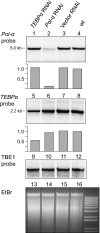RNA-mediated epigenetic regulation of DNA copy number
- PMID: 21078984
- PMCID: PMC3009799
- DOI: 10.1073/pnas.1012236107
RNA-mediated epigenetic regulation of DNA copy number
Abstract
Increasing evidence suggests that parentally supplied RNA plays crucial roles during eukaryotic development. This epigenetic contribution may regulate gene expression from the earliest stages. Although present in a variety of eukaryotes, maternally inherited characters are especially prominent in ciliated protozoa, in which parental noncoding RNA molecules instruct whole-genome reorganization. This includes removal of nearly all noncoding DNA and sorting the remaining fragments, producing extremely gene-rich somatic genomes. Chromosome fragmentation and extensive replication produce variable DNA copy numbers in the somatic genome. Understanding the forces that drive and regulate copy number change is fundamental. We show that RNA molecules present in parental cells during sexual reproduction can regulate chromosome copy number in the developing nucleus of the ciliate Oxytricha. Experimentally induced changes in RNA abundance can both increase and decrease the levels of corresponding DNA molecules in progeny, demonstrating epigenetic inheritance of chromosome copy number. These results suggest that maternal RNA, in addition to controlling gene expression or DNA processing, can also program DNA amplification levels.
Conflict of interest statement
The authors declare no conflict of interest.
Figures




Comment in
-
Modulating somatic DNA copy number through maternal RNA.Proc Natl Acad Sci U S A. 2010 Dec 21;107(51):21951-2. doi: 10.1073/pnas.1017135108. Epub 2010 Dec 13. Proc Natl Acad Sci U S A. 2010. PMID: 21149732 Free PMC article. No abstract available.
Similar articles
-
Modulating somatic DNA copy number through maternal RNA.Proc Natl Acad Sci U S A. 2010 Dec 21;107(51):21951-2. doi: 10.1073/pnas.1017135108. Epub 2010 Dec 13. Proc Natl Acad Sci U S A. 2010. PMID: 21149732 Free PMC article. No abstract available.
-
RNA-dependent control of gene amplification.Proc Natl Acad Sci U S A. 2010 Dec 21;107(51):22134-9. doi: 10.1073/pnas.1009284107. Epub 2010 Oct 25. Proc Natl Acad Sci U S A. 2010. PMID: 20974970 Free PMC article.
-
DNA elimination in ciliates: transposon domestication and genome surveillance.Annu Rev Genet. 2011;45:227-46. doi: 10.1146/annurev-genet-110410-132432. Epub 2011 Sep 9. Annu Rev Genet. 2011. PMID: 21910632 Review.
-
Small RNA-mediated regulation of DNA dosage in the ciliate Oxytricha.RNA. 2018 Jan;24(1):18-29. doi: 10.1261/rna.061333.117. Epub 2017 Oct 27. RNA. 2018. PMID: 29079634 Free PMC article.
-
The unusual organization and processing of genomic DNA in hypotrichous ciliates.Trends Genet. 1992 Dec;8(12):439-45. doi: 10.1016/0168-9525(92)90328-2. Trends Genet. 1992. PMID: 1337226 Review.
Cited by
-
Chromosome copy number variation and control in the ciliate Chilodonella uncinata.PLoS One. 2013;8(2):e56413. doi: 10.1371/journal.pone.0056413. Epub 2013 Feb 20. PLoS One. 2013. PMID: 23437129 Free PMC article.
-
27nt-RNAs guide histone variant deposition via 'RNA-induced DNA replication interference' and thus transmit parental genome partitioning in Stylonychia.Epigenetics Chromatin. 2018 Jun 12;11(1):31. doi: 10.1186/s13072-018-0201-5. Epigenetics Chromatin. 2018. PMID: 29895326 Free PMC article.
-
Nanochromosome copy number does not correlate with RNA levels though patterns are conserved between strains of the ciliate morphospecies Chilodonella uncinata.Protist. 2014 Aug;165(4):445-51. doi: 10.1016/j.protis.2014.04.005. Epub 2014 May 9. Protist. 2014. PMID: 24907652 Free PMC article.
-
Oxytricha as a modern analog of ancient genome evolution.Trends Genet. 2012 Aug;28(8):382-8. doi: 10.1016/j.tig.2012.03.010. Epub 2012 May 21. Trends Genet. 2012. PMID: 22622227 Free PMC article. Review.
-
RNA-Mediated Epigenetic Programming of Genome Rearrangements.Annu Rev Genomics Hum Genet. 2011;12:367-89. doi: 10.1146/annurev-genom-082410-101420. Annu Rev Genomics Hum Genet. 2011. PMID: 21801022 Free PMC article. Review.
References
-
- Emerson JJ, Cardoso-Moreira M, Borevitz JO, Long M. Natural selection shapes genome-wide patterns of copy-number polymorphism in Drosophila melanogaster. Science. 2008;320:1629–1631. - PubMed
-
- Cooper GM, Nickerson DA, Eichler EE. Mutational and selective effects on copy-number variants in the human genome. Nat Genet. 2007;39(7 suppl):S22–S29. - PubMed
-
- Hyman E, et al. Impact of DNA amplification on gene expression patterns in breast cancer. Cancer Res. 2002;62:6240–6245. - PubMed
Publication types
MeSH terms
Substances
Grants and funding
LinkOut - more resources
Full Text Sources

